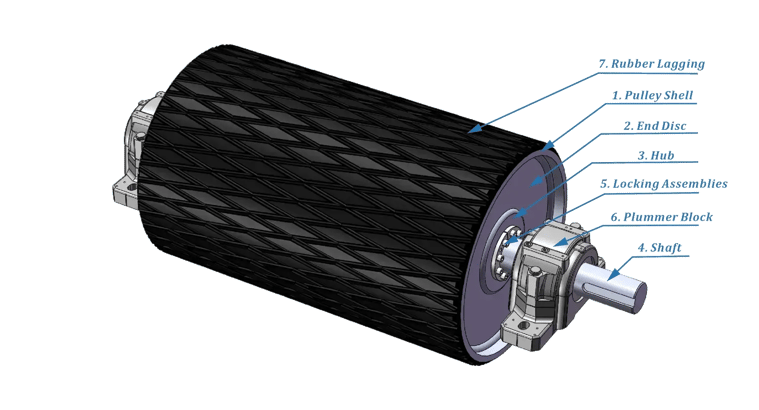Conveyor belts form the backbone of countless Western Australian industries. To ensure your system is efficient and well maintained, it's important you monitor one its most important elements: the Pulleys.
Among the most commonly mentioned are drive pulleys and head pulleys. Understanding the difference between these two units is key in choosing a replacement that suits your site's conditions and enables operational efficiency long into the future.
At Promet, we supply new, high performance replacement conveyor pulleys for mining, bulk handling and other industries. Built for heavier loads and reduced downtime, our units cost less than the price of full refurbishment.
-
What Is a Head Pulley?
Positioned at the discharge end of the conveyor, a head pulley is responsible for moving the belt forward. It's the point where material exists the conveyor and where most of the torque from the drive is applied.
Because they're made to take the full force of the belt's load and friction, head pulleys often succumb to high stress and wear - particularly in WA's mining environments. It's also worth noting that this area is prone to slippage, meaning a head pulley needs quality lagging to guarantee reliable operation. Some head pulleys are also designed with a slight crowned shape to help centre the belt during operation, improving tracking and reducing edge wear under variable load conditions.
In short, think of a head pulley as the working face of the conveyor, driving the belt and transferring the system's power into motion.
What Is a Drive Pulley?
The drive pulley is the component connected directly to the conveyor's power source. It transmits torque to the belt by creating friction between the it and the lagged pulley surface.
In many systems, the head and drive pulley will be the same unit, performing both the discharge and driving functions. But in a larger, more complex arrangement, a separate drive pulley will protect the conveyor against issues caused by additional wrap angles and higher torque.
Drive pulleys can also appear in dual drive or tandem configurations, sharing the load across multiple belts to reduce wear and slippage.
The Key Differences
The head and drive pulley might have a similar function, but their purpose and placement are very different:
Feature
Head Pulley
Drive Pulley
Primary Function
Discharges material and drives the belt
Transmits torque from motor/gearbox
Typical Location
Discharge end of conveyor
Can be at discharge or elsewhere in drive system
Power Source Connection
Sometimes
Always
Lagging Type
High traction (rubber or ceramic)
High traction or reinforced, depending on torque
Common Stress Points
Belt contact surface and bearings
Shaft and torque transfer area
Every drive pulley is part of the power system, but not every head pulley has to be the drive pulley. But remember, if you can't spot both units, it’s likely they are one and the same.
Head or Drive? Which Should You Choose When Replacing a Conveyor Pulley?
If you're upgrading your conveyor system to cope with higher loads or longer runs, it's important to assess both the head and drive pulleys. Take a look at torque capacity, traction and structural strength to see where the most pressing issues lie.
In many cases, refurbishing your existing units may not be enough, especially where the original design was rated for lighter duties. At Promet, our team will often recommend full replacement if:
-
Load or speed requirements have increased
-
Belt slippage occurs even after retensioning
-
The pulley shell or shaft shows visible wear or cracking
-
Bearings are failing prematurely
With a new pulley, you eliminate structural weaknesses, improve efficiency and ensure compliance with updated standards. Working with Promet, all of that can be achieved for less than the cost of refurbishment.
Lagging Options for Drive and Head Pulleys
Choosing the right lagging material will prevent belt slippage, manage torque transfer and protect the system against material build up. Promet stocks a range of high traction surfaces suited to heavy duty mining applications and compatible with both drive and head pulleys:
-
Rubber Lagging: Smooth, diamond grooved, or chevron patterns for general mining and wet conditions.
-
Ceramic Lagging: Dimpled or hybrid for high tension applications requiring maximum grip.
-
Polyurethane Lagging: Resistant to chemicals and ideal for processing areas.
-
Flame Resistant Lagging: For coal and other hazardous environments.
All lagging is reinforced and available via hot vulcanised or cold bonded applications.
The Promet Difference
For over 7 years, we have facilitated conveyor pulley replacement solutions on sites across Western Australia. All Promet components are designed for the demands of the mining and resources sector and are:
-
Manufactured with corrosion resistant materials and reinforced lagging
-
Tested for tension, vibration and thermal performance
-
Delivered quickly to minimise downtime
-
Backed by an 18 month full replacement guarantee
Working with trusted partners, we can replace lagged head pulleys for less than the cost of full refurbishment.
Submit Your Drawings for a Cost and Obligation Free Quote
Understanding the distinction between head and drive pulleys is important in creating a system that is streamlined, well maintained and upgraded correctly. While the two may often work as one, larger conveyor systems will benefit from two high quality units.
Promet is a proud supplier of new, high performance conveyor belt components that are built for heavier loads and longer service life. If you are in need of a head or drive pulley, crowned or straight faced, please submit your drawings for a cost and obligation free quote returned in 5 days.
-
contact us!




